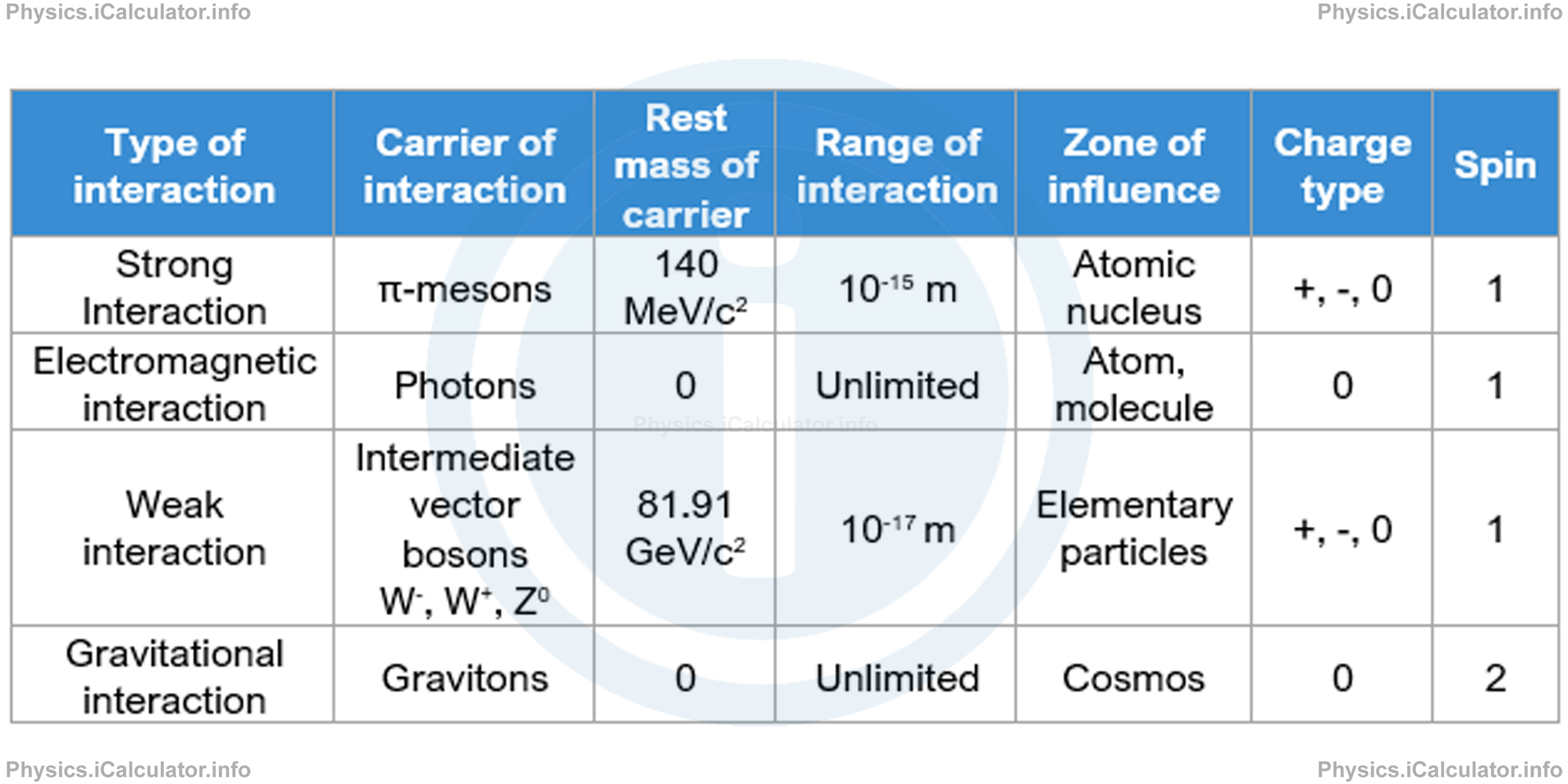Menu
Physics Lesson 21.3.1 - Types of Interaction
Please provide a rating, it takes seconds and helps us to keep this resource free for all to use
Welcome to our Physics lesson on Types of Interaction, this is the first lesson of our suite of physics lessons covering the topic of Classification of Elementary Particles. Quarks and Charm, you can find links to the other lessons within this tutorial and access additional physics learning resources below this lesson.
Types of Interaction
As discussed in the previous articles, the last 80-90 years, especially the second half of 20th century were very prolific in the discovery of new elementary particles. So far, four basic types of interaction were known:
- Strong interaction. This is an interaction experienced by all elementary particles except leptons, photons and gravitons (elementary particles still not identified experimentally to this date that are thought to be responsible for the gravitational attraction). The nuclear forces acting between nucleons are explained relying on the concept and existence of strong interaction.
- Electromagnetic interaction. This is an interaction experienced by all electrically charged elementary particles. All biological and chemical reactions take place due to the existence of such an interaction. Electromagnetic interaction determines the matter structure outside the nucleus. In the macroscopic level, electromagnetic effects are evident when photons are generated and absorbed.
- Weak interaction. It is present in all types of beta decay, in many elementary particles decay processes, as well as in all processes involving neutrino interaction with matter. All particles are affected by weak interaction except graviton. This type of interaction is the most relevant for neutrino. Weak interaction is encountered during the fission processes of many unstable particles (muons in electrons, pions in mesons, Σ-hyperons in protons and so on).
- Gravitational interaction. This is an interaction experienced by all particles without exception, but since it is very weak, it is often neglected when dealing with elementary particles. Gravitational interaction is very small even when compared with electromagnetic interaction, as discussed in Section 14. You can easily prove that EM repulsion between two protons in an atomic nucleus is about 1036 times greater than gravitational attraction between them (you can find the ratio k · q1 · q2/G · m1 · m2 and obtain the above approximate value). Gravitational interaction is considerable only in massive objects such as celestial bodies.
The table below summarizes some principal data regarding the four fundamental interactions.

You have reached the end of Physics lesson 21.3.1 Types of Interaction. There are 6 lessons in this physics tutorial covering Classification of Elementary Particles. Quarks and Charm, you can access all the lessons from this tutorial below.
More Classification of Elementary Particles. Quarks and Charm Lessons and Learning Resources
Whats next?
Enjoy the "Types of Interaction" physics lesson? People who liked the "Classification of Elementary Particles. Quarks and Charm lesson found the following resources useful:
- Types Feedback. Helps other - Leave a rating for this types (see below)
- Elementary Particles Physics tutorial: Classification of Elementary Particles. Quarks and Charm. Read the Classification of Elementary Particles. Quarks and Charm physics tutorial and build your physics knowledge of Elementary Particles
- Elementary Particles Revision Notes: Classification of Elementary Particles. Quarks and Charm. Print the notes so you can revise the key points covered in the physics tutorial for Classification of Elementary Particles. Quarks and Charm
- Elementary Particles Practice Questions: Classification of Elementary Particles. Quarks and Charm. Test and improve your knowledge of Classification of Elementary Particles. Quarks and Charm with example questins and answers
- Check your calculations for Elementary Particles questions with our excellent Elementary Particles calculators which contain full equations and calculations clearly displayed line by line. See the Elementary Particles Calculators by iCalculator™ below.
- Continuing learning elementary particles - read our next physics tutorial: Elementary Particles
Help others Learning Physics just like you
Please provide a rating, it takes seconds and helps us to keep this resource free for all to use
We hope you found this Physics lesson "Classification of Elementary Particles. Quarks and Charm" useful. If you did it would be great if you could spare the time to rate this physics lesson (simply click on the number of stars that match your assessment of this physics learning aide) and/or share on social media, this helps us identify popular tutorials and calculators and expand our free learning resources to support our users around the world have free access to expand their knowledge of physics and other disciplines.